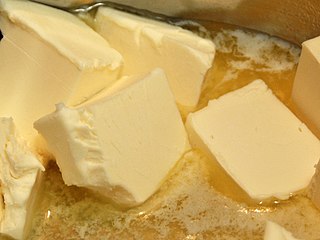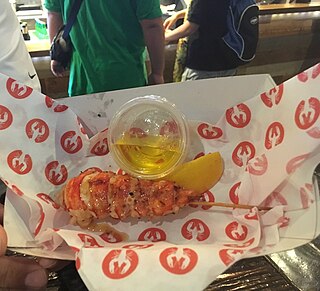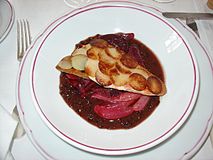
An emulsion is a mixture of two or more liquids that are normally immiscible owing to liquid-liquid phase separation. Emulsions are part of a more general class of two-phase systems of matter called colloids. Although the terms colloid and emulsion are sometimes used interchangeably, emulsion should be used when both phases, dispersed and continuous, are liquids. In an emulsion, one liquid is dispersed in the other. Examples of emulsions include vinaigrettes, homogenized milk, liquid biomolecular condensates, and some cutting fluids for metal working.

Butter is a dairy product made from the fat and protein components of churned cream. It is a semi-solid emulsion at room temperature, consisting of approximately 80% butterfat. It is used at room temperature as a spread, melted as a condiment, and used as a fat in baking, sauce-making, pan frying, and other cooking procedures.

Drawn butter is melted butter, often served as a sauce for steamed seafood. Some cooks restrict the term to clarified butter, while others insist that it should not be clarified.

Mayonnaise, colloquially referred to as "mayo", is a thick, cold, and creamy sauce commonly used on sandwiches, hamburgers, composed salads, and French fries. It also forms the base for various other sauces, such as tartar sauce, fry sauce, remoulade, salsa golf, ranch dressing, and rouille.

In cooking, a sauce is a liquid, cream, or semi-solid food, served on or used in preparing other foods. Most sauces are not normally consumed by themselves; they add flavor, moisture, and visual appeal to a dish. Sauce is a French word taken from the Latin salsa, meaning salted. Possibly the oldest recorded European sauce is garum, the fish sauce used by the Ancient Romans, while doubanjiang, the Chinese soy bean paste is mentioned in Rites of Zhou in the 3rd century BC.

Chateaubriand is a dish that traditionally consists of a large front cut fillet of tenderloin grilled between two lesser pieces of meat that are discarded after cooking. While the term originally referred to the preparation of the dish, Auguste Escoffier named the specific front cut of the tenderloin the Chateaubriand.

Hollandaise sauce, meaning Dutch sauce in French, is a mixture of egg yolk, melted butter, and lemon juice. It is usually seasoned with salt, and either white pepper or cayenne pepper.

Béarnaise sauce is a sauce made of butter, egg yolk, white-wine vinegar, and herbs. It is regarded as a "child" of hollandaise sauce. The difference is only in the flavoring: béarnaise uses shallot, black pepper, and tarragon, while hollandaise uses white pepper or a pinch of cayenne.

A velouté sauce is a savory sauce that is made from a roux and a light stock. It is one of the "mother sauces" of French cuisine listed by chef Auguste Escoffier in the early twentieth century, along with espagnole, tomato, béchamel, and mayonnaise or hollandaise. Velouté is French for 'velvety'.

Vinaigrette is made by mixing an oil with a mild acid such as vinegar or lemon juice. The mixture can be enhanced with salt, herbs and/or spices. It is used most commonly as a salad dressing, but can also be used as a marinade. Traditionally, a vinaigrette consists of 3 parts oil and 1 part vinegar mixed into a stable emulsion, but the term is also applied to mixtures with different proportions and to unstable emulsions which last only a short time before separating into layered oil and vinegar phases.

Deglazing is a cooking technique for removing and dissolving browned food residue from a pan to flavor sauces, soups, and gravies.

The Château de Goulaine is a historic château located in the Loire Valley wine region near Nantes, France. The property has been home to the family of the marquis de Goulaine for over a thousand years. The Goulaine name is also used for estate-bottled wine that is produced at the property.

Wine sauce is a culinary sauce prepared with wine as a primary ingredient, heated and mixed with stock, butter, herbs, spices, onions, garlic and other ingredients. Several types of wines may be used, including red wine, white wine and port wine. Some versions are prepared using a reduction. Several types of wine sauces exist, and it is used in many dishes, including those prepared with seafood, poultry and beef. Wine sauces are associated with French cuisine.

Beurre maître d'hôtel, also referred to as maître d'hôtel butter, is a type of compound butter of French origin, prepared with butter, parsley, lemon juice, salt and pepper. It is a savory butter that is used on meats such as steak, fish, vegetables and other foods. It may be used in place of a sauce, and can significantly enhance a dish's flavor. Some variations with a sweet flavor exist. It is usually served cold as sliced disks on foods, and is sometimes served as a side condiment.

Sautéed mushrooms is a dish prepared by sautéing edible mushrooms. It is served as a side dish, used as an ingredient in dishes such as coq au vin, beef bourguignon, and foods such as duxelles, as a topping for steaks and toast, and also as a garnish.
Clémence Lefeuvre was a French chef and restaurateur best known for being the inventor of the beurre blanc or white butter sauce.

















